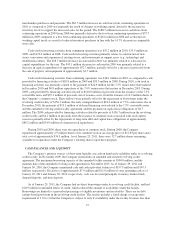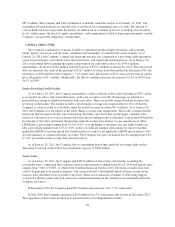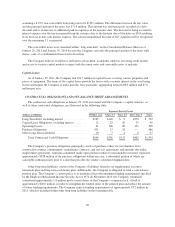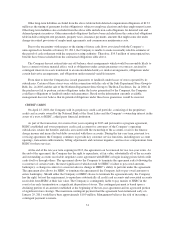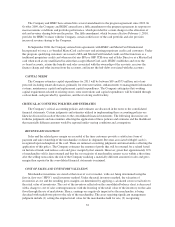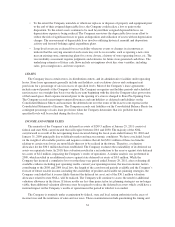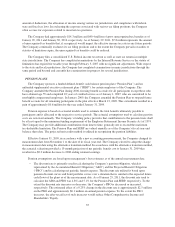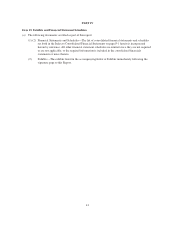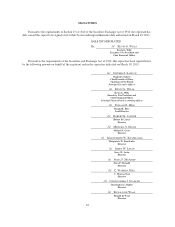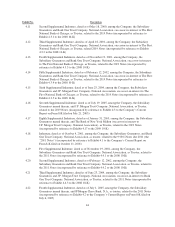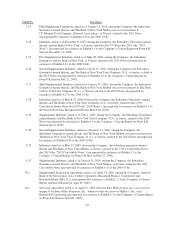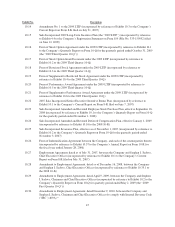Saks Fifth Avenue 2010 Annual Report Download - page 38
Download and view the complete annual report
Please find page 38 of the 2010 Saks Fifth Avenue annual report below. You can navigate through the pages in the report by either clicking on the pages listed below, or by using the keyword search tool below to find specific information within the annual report.On February 1, 2009, the Company retrospectively adopted a new standard related to accounting for
convertible debt instruments that may be settled in cash upon conversion (including partial cash settlement). The
standard specifies that issuers of such instruments should separately account for the liability and equity components
in a manner that will reflect the entity’s nonconvertible debt borrowing rate when interest cost is recognized in
subsequent periods. The effect of the adoption is disclosed in Note 6 to the consolidated financial statements.
In May 2009, the FASB issued guidance regarding subsequent events, which was subsequently updated in
February 2010. This guidance established general standards of accounting for and disclosure of events that occur
after the balance sheet date but before financial statements are issued or are available to be issued. In particular,
this guidance sets forth the period after the balance sheet date during which management of a reporting entity
should evaluate events or transactions that may occur for potential recognition or disclosure in the financial
statements, the circumstances under which an entity should recognize events or transactions occurring after the
balance sheet date in its financial statements, and the disclosures that an entity should make about events or
transactions that occurred after the balance sheet date. This guidance was effective for financial statements issued
for fiscal years and interim periods ending after June 15, 2009, and was therefore adopted by the Company for
the second quarter 2009 reporting. The adoption did not have a significant impact on the subsequent events that
the Company reports, either through recognition or disclosure, in the consolidated financial statements. In
February 2010, the FASB amended its guidance on subsequent events to remove the requirement to disclose the
date through which an entity has evaluated subsequent events, alleviating conflicts with SEC guidance.
In December 2008, the FASB issued additional guidance on employers’ disclosures about the plan assets of
defined benefit pension or other postretirement plans. The new disclosure requirements include a description of
how investment allocation decisions are made, major categories of plan assets, valuation techniques used to
measure the fair value of plan assets, the impact of measurement using significant unobservable inputs and
concentrations of risk within plan assets. The new disclosure requirements are effective for fiscal years ending
after December 15, 2009. See Note 8 to the consolidated financial statements for the disclosures required in
accordance with this accounting standard.
RELATED PARTY TRANSACTIONS
See Item 13, Certain Relationships and Related Transactions, in this Form 10-K.
FORWARD-LOOKING INFORMATION
The information contained in this Form 10-K that addresses future results or expectations is considered
“forward-looking” information within the definition of the Federal securities laws. Forward-looking information
in this document can be identified through the use of words such as “may,” “will,” “intend,” “plan,” “project,”
“expect,” “anticipate,” “should,” “would,” “believe,” “estimate,” “contemplate,” “possible,” and “point.” The
forward-looking information is premised on many factors, some of which are outlined below. Actual
consolidated results might differ materially from projected forward-looking information.
The forward-looking information and statements are or may be based on a series of projections and
estimates and involve risks and uncertainties. These risks and uncertainties include such factors as: the level of
consumer spending for luxury apparel and other merchandise carried by the Company and its ability to respond
quickly to consumer trends; macroeconomic conditions and their effect on consumer spending; the Company’s
ability to secure adequate financing; adequate and stable sources of merchandise; the competitive pricing
environment within the retail sector; the effectiveness of planned advertising, marketing, and promotional
campaigns; favorable customer response to relationship marketing efforts of proprietary credit card loyalty
programs; appropriate inventory management; effective expense control; successful operation of the Company’s
proprietary credit card strategic alliance with HSBC; geo-political risks; the performance of the financial
markets; changes in interest rates; and fluctuations in foreign currency. For additional information regarding
these and other risk factors, please refer to Item 1A of Part I in this Form 10-K.
The Company undertakes no obligation to correct or update any forward-looking statements, whether as a
result of new information, future events, or otherwise.
37


